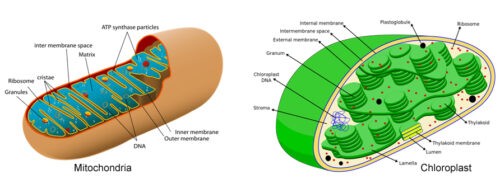The cell is the functional, structural and biological unit of all living organisms. It is of two types such as prokaryotic and eukaryotic cells. The cell contains many types of organelles, among them, some are typically solitary such as the nucleus and golgi complex, while others can be numerous such as mitochondria, lysosomes, chloroplasts, etc. Animal cell does not contain chloroplast while plant cells contain both mitochondria and chloroplast. Mitochondria can produce energy in the form of ATP using oxygen and nutrients for the cell while chloroplast provides space for the process of photosynthesis during production of glucose.
The difference between mitochondria and chloroplast are stated in the following table.
|
Mitochondria |
Chloroplast |
|---|---|
|
1. Mitochondria are found in all eukaryotic cells (animal and plant). |
1. It is found only in the plant cells (except bacteria, certain fungi, and blue-green algae) and in Euglena; |
|
2. It is a double membrane-bounded organelle; It does not contain any pigments; |
2. It is also double membrane-bounded organelle which contains pigments; |
|
3. It is bean-shaped organelle; |
3. It is disc-shaped organelle; |
|
4. It has two chambers: matrix and the cristae; |
4. It also has two chambers: stroma and thylakoid. |
|
5. The inner membrane remains folded which forms critae; |
5. Some portion of the inner membrane remains folded into the matrix and transformed into disc-shaped thylakoid; They pile closely to form grana; |
|
6. The inner chamber is divided into incomplete compartments by cristae; |
6. The inner chamber is not divided; |
|
7. Presence of particles on the inner membrane; |
7. Absence of particles on the inner chamber; |
|
8. 8. It forms respiratory parts of the cell; |
8.It forms the part for synthesis and metabolism of carbohydrate; |
|
9. It produce energy; hence it is known as energy producer or power house of the cell; |
9. It converts one kind of energy into another and thus it is known as energy transducer; |
|
10. It does not take part in photosynthesis; |
10. It takes part in photosynthesis; |
|
11. O2 is used for oxidative phosphorylation; |
11. O2 is not used for oxidative phosphorylation; |
|
12. Carbon dioxide(CO2) and water are produce during energy production; |
12. It stores energy and uses carbon dioxide(CO2) and water to produce glucose |
|
13. It is site for electron transport chain, beta oxidation, oxidative phosphorylation, photorespiration; |
13. It is site for photosynthesis and photorespiration; |

Chloroplast
Also read: Difference between Lysosome and Ribosome

